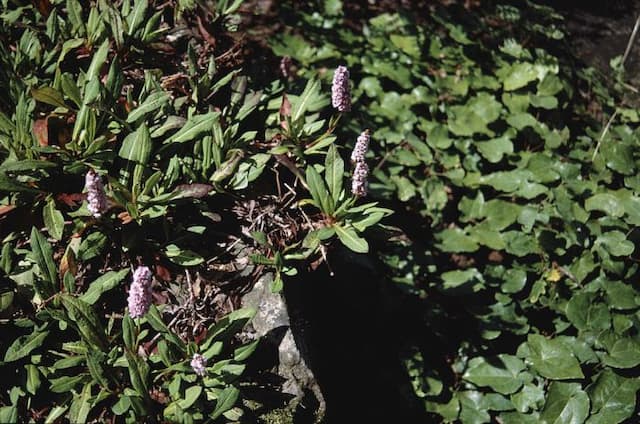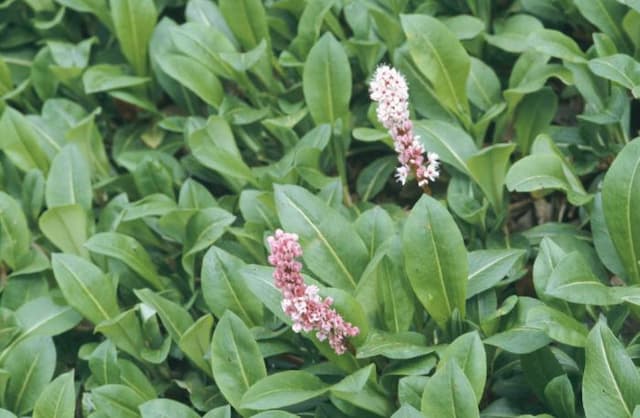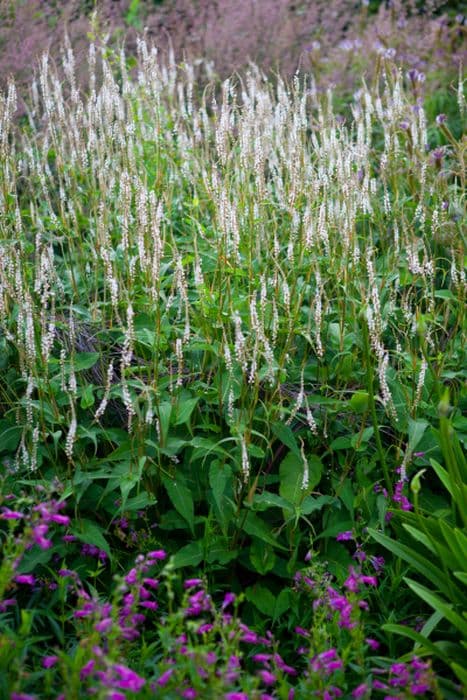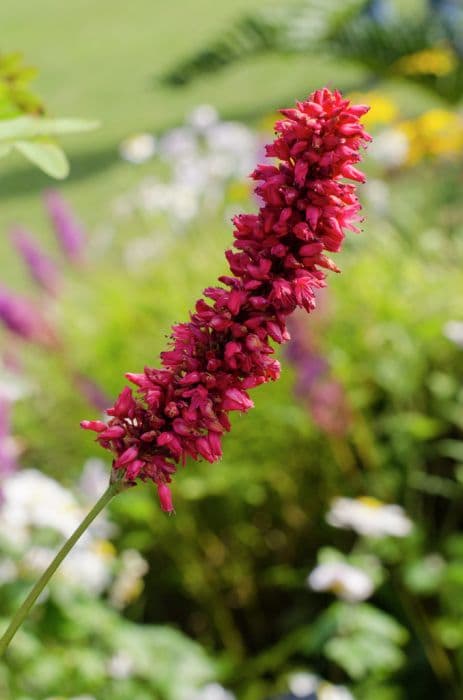Red Bistort Persicaria amplexicaulis Js Seven Oaks Village = 'Js Pesovi'
![red bistort [JS Seven Oaks Village]](/_next/image?url=https%3A%2F%2Fplants-admin.emdemapps.com%2Fimages%2Fplants%2F%2Fimages%2F604b56557c0e3.png&w=3840&q=75)
ABOUT
The plant known as 'Js Seven Oaks Village', distinct amongst the Bistorts, has a robust and vibrant appearance. Its foliage presents a lush green color, with leaves exhibiting a broad and somewhat oval shape, coming to a subtle point at the end. These leaves often appear densely packed, creating a rich backdrop for the distinctive blooms. The flowers themselves are a true highlight, rising above the foliage in striking, slender spires. The color of these blooms can vary significantly, ranging from a deep, passionate red to gentler hues of pink or sometimes even white. Each flower spike is composed of many tiny, closely-packed individual flowers, giving the impression of a slender, tapering wand of color that adds both grace and visual interest to the plant's overall appearance. While the flowers can be quite prominent, the precise hue and fullness of the blooms may change throughout the flowering period, which adds an ever-evolving appeal to the display. The combination of the colorful, elongated flower spikes above rich green leaves creates a two-tiered effect that is particularly appealing in garden settings, providing both color and structure to the planting scheme.
About this plant
 Names
NamesFamily
Polygonaceae
Synonyms
Red Bistort, Mountain Fleece, JS Pesovi
Common names
Persicaria amplexicaulis 'Js Pesovi'
 Toxicity
ToxicityTo humans
The plant known as Bistort or Red Bistort (Persicaria amplexicaulis) 'Js Seven Oaks Village' is not listed as a toxic plant to humans. In general, ingestion of plant parts should still be avoided, and sensitivities or allergic reactions could occur in some individuals.
To pets
Bistort or Red Bistort (Persicaria amplexicaulis) 'Js Seven Oaks Village' is also not listed as a toxic plant to pets. However, as with humans, it is not intended for ingestion and individual animals may have different sensitivities or allergic reactions to the plant if consumed. Owners should always be cautious and prevent pets from ingesting plants not meant for consumption.
 Characteristics
CharacteristicsLife cycle
Perennials
Foliage type
Deciduous
Color of leaves
Green
Flower color
Red
Height
3-4 feet (0.9-1.2 meters)
Spread
2-3 feet (0.6-0.9 meters)
Plant type
Herb
Hardiness zones
5
Native area
Himalayas
Benefits
 General Benefits
General Benefits- Attracts Pollinators: Persicaria amplexicaulis 'Js Seven Oaks Village' is known for attracting bees and butterflies, which are important pollinators in the garden.
- Long Flowering Period: This plant tends to have a long blooming season, providing color and interest from summer into fall.
- Low Maintenance: It generally requires minimal care once established, making it a suitable choice for gardeners of all skill levels.
- Drought Tolerant: Once established, it can tolerate periods of dry weather, making it a good option for gardens in drier climates.
- Deer and Rabbit Resistant: The plant is typically resistant to browsing by deer and rabbits, protecting it from wildlife damage.
- Easy to Propagate: It can be easily propagated by division, allowing gardeners to expand their plantings or share with others.
- Versatile Usage: Can be used in a variety of garden settings including borders, water margins, and cottage gardens.
- Visual Interest: Its tall, slender spikes of flowers create vertical interest, adding texture and depth to garden designs.
 Medical Properties
Medical PropertiesThis plant is not used for medical purposes.
 Air-purifying Qualities
Air-purifying QualitiesThis plant is not specifically known for air purifying qualities.
 Other Uses
Other Uses- Red Bistort 'Js Pesovi' can be used in dye production, as various parts of the plant contain tannins and pigments that might be suitable for creating natural dyes.
- The plant's dense foliage can offer a habitat for beneficial insects such as pollinators and predatory insects that help manage pests in gardens.
- The long-lasting, colourful spikes can be cut and dried for use in floral arrangements, maintaining their appearance for extended periods.
- It may be used as a living mulch due to its dense growth habit, helping to suppress weeds and maintain soil moisture.
- The robust root system of Red Bistort 'Js Pesovi' can help to stabilize soil on slopes and banks, potentially preventing erosion.
- Leaves of the Persicaria amplexicaulis might be used in compost piles as a source of green material, contributing nitrogen to the composting process.
- Its tall and striking stems can serve as a natural trellis for climbing plants that need support.
- When planted en masse, it can provide a dense ground cover that creates a dramatic, textured landscape effect due to its foliage and flower spikes.
- The plant could potentially be used in sensory gardens, as it provides a variety of textures and movement for tactile and visual stimulation.
- It can be introduced into rain gardens, where its ability to thrive in damp conditions can make it a valuable component for managing runoff and improving water quality.
Interesting Facts
 Feng Shui
Feng ShuiThe Persicaria amplexicaulis is not used in Feng Shui practice.
 Zodiac Sign Compitability
Zodiac Sign CompitabilityThe Persicaria amplexicaulis is not used in astrology practice.
 Plant Symbolism
Plant Symbolism- Adaptability - Persicaria amplexicaulis, commonly known as Mountain Fleece, can thrive in a variety of conditions, symbolizing flexibility and the ability to adjust to different environments.
- Resilience - As Mountain Fleece is known for its hardiness and ability to withstand different climates, it represents endurance and the strength to overcome challenges.
- Connection - The way Mountain Fleece spreads across the garden signifies interconnectedness and community, reflecting the plant's ability to create bonds in its natural habitat.
- Growth - The plant's vigorous growth habit stands for personal and spiritual expansion, suggesting continual development and progression in life.
 Water
WaterRed bistort, commonly known as Persicaria amplexicaulis 'Js Pesovi', should be watered deeply once a week to promote strong root growth, especially during its active growing season in spring and summer. During periods of drought or extreme heat, increase watering frequency to twice a week. Aim for approximately one to two gallons per watering session, depending on the soil's moisture level. Always check the soil before watering; it should be moist but not waterlogged. Reduce watering in the fall and winter to prevent root rot when the plant's growth is slower.
 Light
LightRed bistort thrives best in full sun to partial shade. It prefers a spot that provides morning sunlight with some afternoon shade, especially in hotter climates, to protect it from the intense heat. Appropriate lighting will ensure good growth and vibrant flower production.
 Temperature
TemperatureRed bistort is hardy and can tolerate a wide range of temperatures, from as low as 25°F to highs around 85°F, making it suitable for many climates. However, the plant's ideal growing temperature is between 60°F and 75°F. While it can survive minor frost, consistently cold temperatures below 25°F may damage the plant.
 Pruning
PruningPrune red bistort in late winter or early spring to remove any dead or damaged stems and encourage new growth. Cutting back the plant by one-third after the first flowering can promote a second bloom period. Prune again after the second flowering to maintain a tidy appearance. The best time for pruning red bistort is when new shoots start to appear at the plant's base.
 Cleaning
CleaningAs needed
 Soil
SoilThe Mountain Fleece 'Js Pesovi' thrives in moist, fertile, well-draining soil with a pH range of 6.0 to 7.0 (slightly acidic to neutral). A good soil mix may consist of garden soil, compost, and a smaller portion of sand or perlite to improve drainage.
 Repotting
RepottingMountain Fleece 'Js Pesovi' is typically not repotted regularly as it is a garden perennial. Divide and replant approximately every 3 to 5 years to maintain vigor and manage spread.
 Humidity & Misting
Humidity & MistingMountain Fleece 'Js Pesovi' is quite adaptable but prefers average to high humidity levels, similar to outdoor conditions, as it is not usually a houseplant.
 Suitable locations
Suitable locationsIndoor
Not ideal for indoor growing; needs outdoor space.
Outdoor
Plant in partial shade to full sun, keep soil moist.
Hardiness zone
4-8 USDA
 Life cycle
Life cycleRed Bistort 'Js Pesovi' typically begins its life cycle with seed germination in the spring, as soil temperatures rise and moisture becomes more consistent. Following germination, seedlings quickly establish a root system and begin to put out their first leaves, entering the vegetative stage, where they focus on developing foliage and gaining size. As summer progresses, the plant transitions into the flowering stage, producing tall spikes of reddish-pink flowers that attract pollinators such as bees and butterflies. After pollination, the flowers give way to seed production, completing the reproductive stage of the cycle by late summer or early autumn. As temperatures drop with the onset of fall, the plant begins to die back, retreating into dormancy over winter with its energy reserves stored in its root system. With the return of favorable conditions in the next spring, the Red Bistort 'Js Pesovi' resumes growth from the existing rootstock, completing its perennial life cycle.
 Propogation
PropogationPropogation time
Spring to early summer
Persicaria amplexicaulis 'Js Seven Oaks Village', commonly known as Mountain Fleece, is often propagated through division. This method is best carried out in the spring as the new growth begins to emerge. To propagate by division, carefully dig up an established clump of Mountain Fleece and gently separate the plant into smaller sections, ensuring that each section has a portion of the root system attached. Replant these divisions immediately into well-prepared soil at the same depth as the original plant, and water thoroughly to establish. Typically, these divisions should start to grow quickly, taking advantage of the cooler, moist spring weather to establish themselves before the heat of summer sets in.









